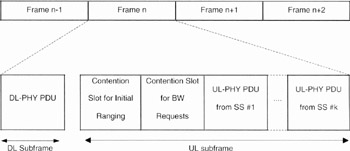9.2 Duplexing: Both FDD and TDD are Possible
9.2 Duplexing: Both FDD and TDD are Possible
The WiMAX/802.16 standard includes the two main duplexing techniques: Time Division Duplexing (TDD) and Frequency Division Duplexing (FDD). The choice of one duplexing technique or the other may affect certain PHY parameters as well as impact on the features that can be supported. Next, each of these duplexing techniques will be discussed.
9.2.1 FDD Mode
In an FDD system, the uplink and downlink channels are located on separate frequencies. A fixed duration frame is used for both uplink and downlink transmissions. This facilitates the use of different modulation types. It also allows simultaneous use of both full-duplex SSs, which can transmit and receive simultaneously and, optionally, half-duplex SSs (H-FDD for Half-duplex Frequency Division Duplex), which cannot. A full-duplex SS is capable of continuously listening to the downlink channel, while a half-duplex SS can listen to the downlink channel only when it is not transmitting on the uplink channel. Figure 9.1 illustrates different cases of the FDD mode of operation.

Figure 9.1: Illustration of different FDD mode operations: broadcast, full duplex and half duplex. Half duplex SSs as SS 1 and 2 in this figure can listen to the channel or (exclusively) send information. (From IEEE Std 802.16-2004 [1]. Copyright IEEE 2004, IEEE. All rights reserved.)
When half-duplex SSs are used, the bandwidth controller does not allocate an uplink bandwidth for a half-duplex SS at the same time as the latter is expected to receive data on the downlink channel, including allowance for the propagation delay uplink/downlink transmission shift delays.
9.2.2 TDD Mode
In the case of TDD, the uplink and downlink transmissions share the same frequency but they take place at different times. A TDD frame (see Figures 9.2 and 9.3) has a fixed duration and contains one downlink and one uplink subframe. The frame is divided into an integer number of Physical Slots (PSs), which help to partition the bandwidth easily. For OFDM and OFDMA PHYsical layers, a PS is defined as the duration of four modulation symbols. The frame is not necessarily divided into two equal parts. The TDD framing is adaptive in that the bandwidth allocated to the downlink versus the uplink can change. The split between the uplink and downlink is a system parameter and the 802.16 standard states that it is controlled at higher layers within the system.

Figure 9.2: TDD frame: uplink and downlink transmissions share the same frequency but have different transmission times. (From IEEE Std 802.16-2004 [1]. Copyright IEEE 2004, IEEE. All rights reserved.)

Figure 9.3: General format of a TDD frame (OFDM PHY). (Based on Reference [1].) In the FDD mode, the downlink subframe and uplink subframes are transmitted on two separate frequencies as the uplink frame and downlink frame. The contents are the same for FDD and TDD.
Mesh topology supports only TDD duplexing.
Comparing the two modes, a fixed duration frame is used for both uplink and downlink transmissions in FDD while the TDD distribution is adaptive. Therefore TDD duplexing is more suitable when data rates are asymmetrical (between the uplink and downlink), e.g. for an Internet transmission.
After settling the question of duplexing, many users have to share the bandwidth resource in each kind of transmission.
[1]IEEE 802.16-2004, IEEE Standard for Local and Metropolitan Area Networks, Air Interface for Fixed Broadband Wireless Access Systems, October 2004.
EAN: 2147483647
Pages: 124